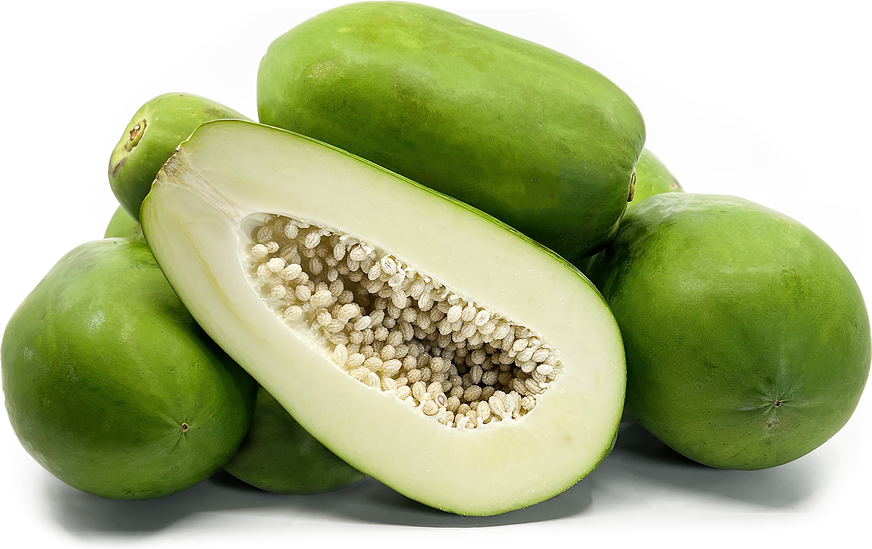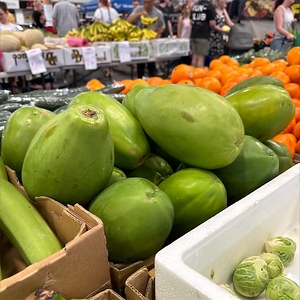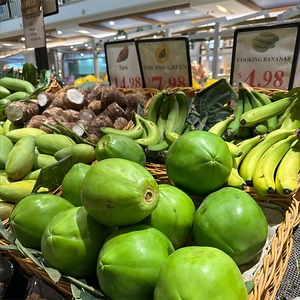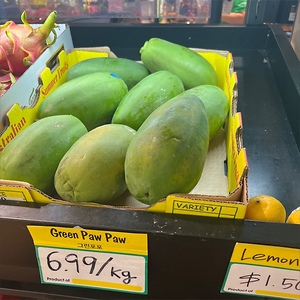


Green Paw Paw
Estimated Inventory, lb : 0
Description/Taste
Green Paw Paws are variable in size, depending on the variety and maturity at harvest, and generally average 10 to 30 centimeters in diameter and 15 to 45 centimeters in length. The fruits have an elongated, oval, to cylindrical shape with blunt, curved ends. The skin is thin, smooth, and taut with a faint sheen and ripens from green to shades of yellow or orange when ripe. Underneath the surface, Green Paw Paws have white flesh, and if the fruits are left to mature, the flesh transitions into shades of yellow, sometimes red or orange, depending on the variety. Young, unripe flesh is dense, firm, crunchy, and lightly aqueous. The flesh also encases a central cavity filled with small white seeds. These seeds turn black as they ripen and have a peppery flavor. After cooking, the flesh softens and becomes crisp and tender. Green Paw Paws are edible raw and have a green, vegetal, tangy, and slightly bitter taste. Cooking the flesh mellows the flavor.
Seasons/Availability
Green Paw Paws are available year-round.
Current Facts
Green Paw Paw, botanically classified as Carica papaya, is the young, unripe version of a tropical fruit belonging to the Caricaceae family. Paw Paw is another term used worldwide for papaya, especially in Australia and Asia. Several name variations are also used, including Papaw, Pawpaw, and Paw Paw, and in Australia, Paw Paw is the general descriptor used for yellow-fleshed papayas. Australian commercial markets label red and orange-fleshed varieties as papaya, and yellow-flesh varieties are called Paw Paws. Popular yellow-flesh Paw Paw varieties include Hybrid 1B, the most commercially grown cultivar, Ritcher Gold, and Hybrids 11B, 13, 14, 29. Green Paw Paws grow on small, upright trees reaching 5 to 10 meters in height and the fruits are picked when young as a culinary and medicinal ingredient. In Australia, Green Paw Paws are the unripe versions of yellow-fleshed cultivars sold in markets for their crunchy flesh and tangy flavor. The fruits are versatile, with the ability to be eaten raw or cooked, and can be used in a wide array of sweet or savory preparations.
Nutritional Value
Green Paw Paws are a source of vitamin C to strengthen the immune system, fiber to regulate the digestive tract, potassium to balance fluid levels within the body, and magnesium to control nerves. The fruits also provide iron to develop the protein hemoglobin for oxygen transport through the bloodstream, calcium to protect bones and teeth, vitamin A to maintain healthy organs, vitamin E to guard the cells against free radical damage, and other nutrients, including phosphorus, zinc, copper, folate, and vitamin K. In natural medicines, Paw Paws are topically applied to heal wounds, burns, and scars or used as a moisturizer and face wash to smooth and cleanse the skin.
Applications
Green Paw Paws have a green, tangy, and vegetal taste suited for fresh and cooked preparations. The young fruits can be shredded and added to salads, and the skin is typically peeled before eating. Once shredded, Green Paw Paws are tossed with sweet and sour dressings to create a crunchy, bright dish, and these mixtures can be added to noodle dishes and rice. Green Paw Paws can also be chopped and used to tenderize meat, sliced as a topping over tacos, added to rice paper rolls, or prepared as a zoodle variation for healthier pasta. In Southeast Asia, Green Paw Paws are incorporated into various relishes and chutney or pickled as a tangy condiment. The fruits can also be stewed, stir-fried, or cut into strips and fried. In Australia, Green Paw Paws are often cooked into various stews, curries, and soups. Beyond culinary preparations, Green Paw Paws are blended into smoothies, canned in syrup, or cut into strips and dried for extended use. Green Paw Paws pair well with spices such as cinnamon, curry powder, turmeric, and chili powder, aromatics including garlic, onions, and ginger, nuts such as peanuts, walnuts, and almonds, meats including beef, poultry, and pork, tofu, and seafood. Whole, unwashed Green Paw Paws will keep for 1 to 2 weeks when stored in a plastic bag in the refrigerator. Some consumers wrap a paper towel around the fruits to absorb excess moisture.
Ethnic/Cultural Info
There is some confusion over the name Paw Paw due to the descriptor being used for two different species in the modern day. Historically, Paw Paw was a term used to describe papaya, and it is thought that English speakers in the Caribbean in the 16th and 17th centuries first used this term as they tried to adapt names from indigenous populations. The first written record of the word Paw Paw was documented in 1598 for papaya, and over time, the name spread in use throughout Australia, New Zealand, Southeast Asia, and South Africa. Later in the 18th century, Paw Paw was adapted and used for the fruits of a North American species called Asimina triloba. This species was named Pawpaw as it had green-skinned fruits reminiscent of young papaya, and English speakers used the name, making the name stick. In North America, when consumers refer to Pawpaw, they are mostly describing the local species Asimina triloba. In Australia, Asia, and South Africa, Paw Paw is primarily used for papaya, belonging to the species Carica papaya.
Geography/History
Green Paw Paws, also known as papayas, are native to the Americas and are descendants of wild species that have been naturally growing since ancient times. The center of origin for the wild species is thought to have been in the lowlands of Eastern Central America, spanning from Mexico to Panama. Over time, multiple species were hypothesized to have been hybridized, and indigenous populations in Mesoamerica first domesticated the species. Seeds of the species could be stored for several years once dried, and these seeds were eventually carried from the Americas to the Caribbean and Europe by Spanish and Portuguese explorers around the 16th century. Early Paw Paw species were being grown in India by the 17th century and spread to regions of Africa, Southeast Asia, and the South Pacific in the 19th century. Paw Paw species have been present in Australia since the 19th century. Several species have been commercially bred in Australia, and the fruits are primarily grown in Northern Queensland. Around 95% of the fruits are cultivated in areas of Northern Queensland, found in Gympie, Yarwun, the Sunshine Coast district, Proserpine, Innisfail, Mareeba, Yarwun, and Yeppoon. Outside of Northern Queensland, the Northern Territory, Western Australia, and parts of New South Wales also commercially grow the species. Today, Green Paw Paws are grown and sold worldwide, but the fruits sold under this name are generally found in Australia, New Zealand, Asia, and Africa.
Recipe Ideas
Recipes that include Green Paw Paw. One
| Hunt Gather Cook |
|
Paw Paw Ice Cream |










